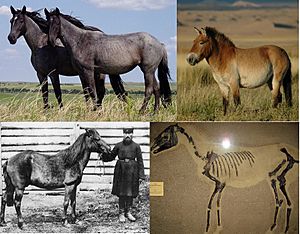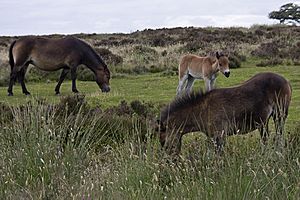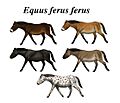Wild horse facts for kids
Quick facts for kids Wild horse |
|
|---|---|
 |
|
| Top left: Equus ferus caballus (horses) Top right: Equus ferus przewalskii (Przewalski's horse) Below left: Equus ferus ferus (tarpan) |
|
| Conservation status | |
| Scientific classification | |
| Subspecies | |
The wild horse (Equus ferus) is a type of animal in the Equus family. This family also includes modern domesticated horses. There are three main kinds, or subspecies, of Equus ferus. These are the domesticated horse (Equus ferus caballus), the tarpan (Equus ferus ferus), and Przewalski's horse (Equus ferus przewalskii).
The tarpan is now extinct, meaning it no longer exists. Przewalski's horse was almost extinct but has been brought back into the wild. Scientists think the tarpan might be an ancestor of today's domestic horses. It used to live on the wide, flat lands called steppes in Europe and Asia.
Sometimes, people call free-roaming horses "wild horses." Examples include the mustangs in the United States or the brumbys in Australia. But these horses are actually feral horses. This means their ancestors were once domesticated horses that later became wild again. They are not truly "wild" like Przewalski's horse, which was never domesticated.
Contents
Where Wild Horses Lived
Evidence shows that Equus ferus first appeared in North America. This was about 1.1 to 1.2 million years ago. Around 800,000 to 900,000 years ago, these horses moved. They traveled west to Europe, Asia, and North Africa. They used a land bridge called the Bering Land Bridge. They also went south to South America through the Isthmus of Panama.
By the middle to late Pleistocene era, wild horses lived in many places. They were found across the Americas, Europe, Asia, and North Africa. Many horse fossils from this time were once thought to be different species. But now, scientists believe they were all the same species, Equus ferus.
By the end of the Pleistocene or early Holocene era, horses disappeared from the Americas. Only populations in the Old World (Europe, Asia, Africa) remained. Wild horses were still common there. Around 3600 B.C., some were domesticated by humans. But wild populations kept shrinking. The last truly wild tarpans died out in Eastern Europe and Russia in the late 1800s. Przewalski's horse became extinct in the wild in 1969.
However, in recent centuries, feral horses have been brought to almost every continent. Przewalski's horses have also been reintroduced to their old homes in Mongolia.
How Wild Horses Live
Wild horses are mostly grazers. This means they eat grass and other plants. They like to live in open areas. These areas include steppes and grasslands. Their food choices might change with the seasons.
Wild horses can become prey for other animals. These animals include wolves, cougars, and spotted hyenas. These predators are part of the natural balance where horses live.
Types of Wild Horses and Their History
Equus ferus has had several subspecies. Only three of them have survived into modern times:
- The domestic horse (Equus ferus caballus).
- The tarpan or Eurasian wild horse (Equus ferus ferus). This horse lived in Europe and western Asia. It became extinct in the late 1800s. The last one died in 1909 while in captivity.
- Przewalski's horse (Equus ferus przewalskii). This horse is also called the Mongolian wild horse or takhi. It lives in Central Asia and the Gobi Desert.
The tarpan and Przewalski's horse are the only groups that were never domesticated. They survived into modern history. However, other types of Equus ferus might have existed long ago.
In the Late Pleistocene era, there were other subspecies of Equus ferus. All of them are now extinct. It is complex to sort out all the different types of Equus remains. Scientists are still working on this.
Przewalski's Horse
Przewalski's horse used to live in the eastern Eurasian Steppes. This area stretched from the Urals to Mongolia. It became extinct in the wild in the 1960s. But it was brought back in the late 1980s. They were reintroduced to two special areas in Mongolia.
Scientists once thought Przewalski's horse was an ancestor of modern domestic horses. But newer genetic studies show this is not true. Instead, it was later suggested that Przewalski's horse might be wild descendants of horses from the Botai culture.
Przewalski's horse is still alive today. But it is an endangered species. For a while, it was thought to be extinct in the wild. About 2000 Przewalski's horses live in zoos around the world. A small group has been reintroduced in Mongolia. As of 2005, there were 248 animals living in the wild. This was thanks to a project between the Zoological Society of London and Mongolian scientists.
Przewalski's horse is a bit different from domestic horses. Domestic horses have 64 chromosomes. Przewalski's horse has 66 chromosomes. But if a Przewalski's horse and a domestic horse have babies, the babies can have their own babies. These offspring have 65 chromosomes.
Feral Horses

Horses that live in the wild but have ancestors that were once domesticated are called "feral horses." For example, when the Spanish brought horses to the Americas, some escaped. These horses formed wild herds. The most famous are the mustangs. The brumbys in Australia also came from horses that escaped or were set free by English settlers.
You can find groups of feral horses in many places. These include Bosnia, Croatia, New Zealand, Portugal, and Scotland. They also live on some islands along the Atlantic coast of North America. Even though people often call them "wild" horses, they are not truly wild. This is because their ancestors were once domesticated.
In 1995, explorers found a new group of horses in the Riwoche Valley in Tibet. These horses were unknown to most of the world. Local people used them. Some thought the Riwoche horse might be a truly wild horse. But genetic tests showed they were like domesticated horses. News reports also said that local villagers used them for carrying things and riding. These horses are about 12 hands tall. They are said to look like horses shown in old cave paintings.
Images for kids
-
Equus ferus fossil from 9100 BC found near Odense, at the Zoological Museum in Copenhagen
See also
 In Spanish: Equus ferus para niños
In Spanish: Equus ferus para niños




